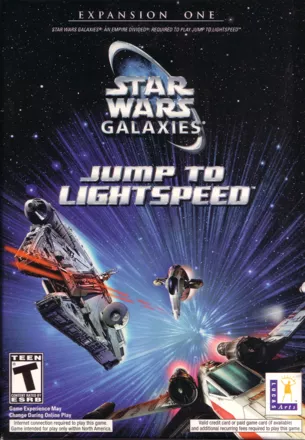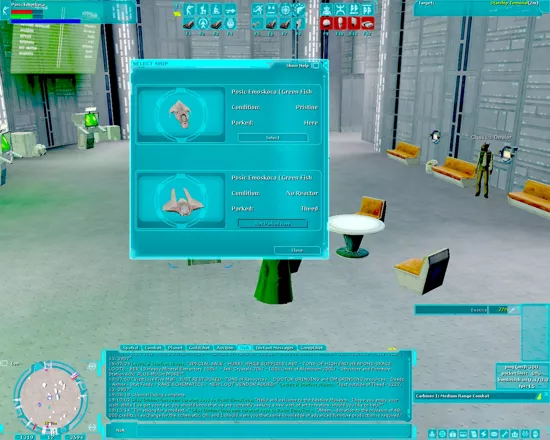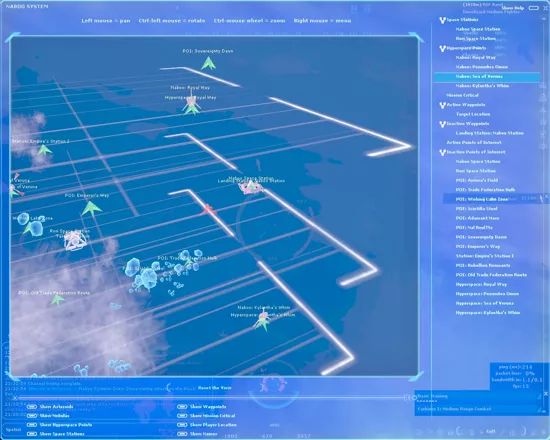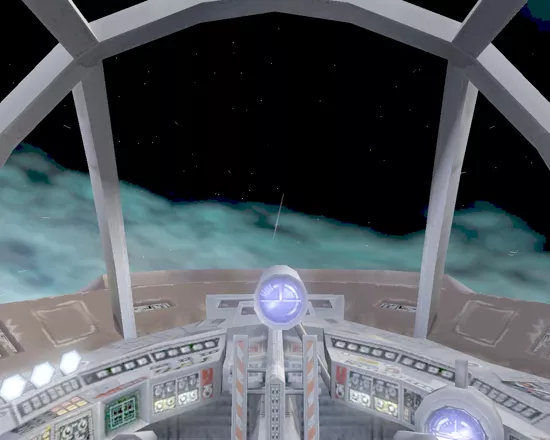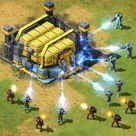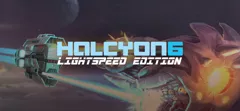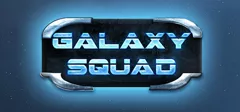Star Wars: Galaxies - Jump to Lightspeed
Description
Star Wars: Galaxies - Jump to Lightspeed is the first expansion to Star Wars: Galaxies - An Empire Divided. It focuses on space and adds real-time space combat; players can fly as Rebels or Imperials, and continue the Galactic Civil War when off-planet. It is also possible to fly as a Freelancer, in which case the faction is decided by the trainer (flying as either Corellia or Naboo security forces, or as one of Jabba's smugglers).
Many classic ships are available to fly - including the TIE fighter, TIE Advanced (Vader's ship), Y-Wing, X-Wing, and the KSE Firespray (Boba Fett's ship from Empire Strikes Back). Other famous, non-controllable ships include the tri-winged Imperial shuttle, the Corellian Corvette (Leia's Tantive IV from the opening scene in A New Hope) and even a massive Star Destroyer that can be attacked and destroyed inside a PvP battleground.
Ace pilots earn the ability to fly massive "player-on-board" craft appropriate to their faction, such as the YT-1300 (Millennium Falcon) for Freelancers. These ships have interiors that allow grouped players to move around inside, store items, or even man turrets and fix systems damaged during combat.
Each pilot profession has three unique story-driven series of missions, with a different series of trainers (some of which are notable Star Wars characters) that lead you from rookie pilot to ace. The expansion also adds four new player professions that directly support starship combat and starship construction, and two new player races - Ithorians ("Hammerheads" in A New Hope) and Sullustans (Lando's co-pilot in Return of the Jedi).
Spellings
- 星球大战银河风暴:光速飞行 - Simplified Chinese spelling
Groups +
Screenshots
Videos
See any errors or missing info for this game?
You can submit a correction, contribute trivia, add to a game group, add a related site or alternate title.
Credits (Windows version)
354 People (317 developers, 37 thanks) · View all
| Executive Producer | |
| Senior Producer | |
| Producer | |
| Associate Producer | |
| Senior Buildmaster | |
| Buildmaster | |
| Community Managers | |
| Community Representatives | |
| Events Manager | |
| Events Coordinator | |
| Administration | |
| JTL Lead Programmer | |
| JTL Programmers | |
| Technical Director | |
| Live Lead Programmer | |
| [ full credits ] | |
Reviews
Critics
Average score: 76% (based on 13 ratings)
Players
Average score: 3.0 out of 5 (based on 8 ratings with 2 reviews)
The Good
Truth is, I didn't get into Star Wars Galaxies until Jump to
Lightspeed. I had heard of SWG, but was wary of this "new" MMO idea, and wasn't clear on the compelling reasons to pay a monthly fee for a game. Then, JtL came out and I couldn't jump on board fast
enough.
This was entirely because I adored the X-Wing/TIE Fighter series, and I thought JtL was a grand-scale sequel to those games. It wasn't - which we'll touch on in a minute - but I had completely intended to get absorbed in the flight game and treat anything ground-related as a mere pit stop, or overly elaborate chat room. Flaws in JtL's systems, and the fascinating sandbox stuff original SWG was doing, mean the opposite ended up being true.
Jump to Lightspeed is, simply, the space combat that was promised on launch and held back when it was discovered that plan would be too ambitious. The expansion introduces new space zones around every planet in the game, plus two PvP areas - Kessel and Deep Space. Players gained the option to swear allegiance to either the Rebels, Imperial Navy, or a few different pilot trainers as a Freelancer, and ranked up through exclusive ship tiers in each of the three factions. New crafting options, and two new playable species (Sullustians and Ithorians), created a new Shipwright economy for engineers that didn't take long to get really booming - and unique aspects to that field made it one of the most interesting crafting options in the entire game.
Graphically, it was a powerhouse, and remains impressive even today. Planets were absolutely huge - some of the biggest views ever in a space game - and even featured layers of rolling atmospheric effects if you stopped to watch. Lighting was affected by whatever suns were in that system, and cast dynamically. Zones themselves were actually quite large, and featured plenty of sights like nebulae, debris fields from previous battles, and space stations with missions sometimes available. Ships and asteroids featured basic bump mapping, so the sunlight highlight pits and edges. Each planetary zone also looked distinct and different from the others, and all had their own plausible beauty without resorting to bombastic space phenomena or boring endless starfields.
Each ship had a fully 3D cockpit. While instruments were not live and functional, you could still look around freely or use a third person view. An extension of this, and the star of JtL's show, were the "Player On Board" ships. These featured fully 3D interiors which players could walk around freely inside at any time - even while the ship was moving. Functionally, they acted much like houses in space, and could be decorated and explored as such. The pilot returned to the JtL flight interface by sitting in the pilot's seat, while the rest of his passengers were free to watch out the windows (a live and accurate view), roam, chat, or assist in combat. Damaged ships could blow power conduits, venting fire into the passenger compartments. Passengers could repair these with disposable kits, and return that damaged part to working order as well. One passenger could also act as the "co-pilot" and manage all the droid commands. As for the rest of the crew? Send them up into the working turrets to fend off attackers while you focus on flying!
Next, the gameplay itself. In stark contrast to Galaxies' traditional auto-attack and toolbar ground combat, JtL is off-rails and twitch-based. The mechanics are identical to any of the great space shooters that came before it - Freespace, Wing Commander, X-Wing - and it amazingly worked just as well. The ground game occasionally suffered from some wonky lag-related effects, but JtL almost always ran clean. Combat was as fast and smooth as if you were playing a single player game. Though to achieve this, ships were only drawn in a somewhat limited spherical range around your ship. This made it easy to lose friends if they flew too far away, or for enemies to suddenly spawn in nearby.
Ships were customizable based on hardpoints, similar to other flight or mech games. Players unlocked the rights to fly increasingly powerful chassis as they progressed, starting with lowly patrol craft and working their way up to X-Wings and advanced TIE fighters. This was just the bare frame of the ship though, and all parts needed to be acquired and installed - engines, shields, weapons, capacitors, armor and droid computers. Aside from the hardpoints limiting the actual number of weapons you could install, each chassis also had a weight limit forcing you to make compromises regarding what you put in. Further, each ship required a reactor with its own weight statistic, which generated a fixed amount of power. None of your installed electronics could go over this power limit either.
Parts were looted in space from destroying other craft, or bought from traders. Loot here was actually some of the best implementation of loot in Galaxies up to that point (the ground game at this point was reluctant to hand out anything that would be poaching on the player economy). You could more than serviceably kit out a ship just with looted parts, so actually getting the materials necessary to fly was rarely an issue. You could also sell any unwanted loot to an NPC for a low, fixed price, or sell it to player shipwright at whatever price they were willing to pay. I set up a good relationship with a crafter just dumping off all the parts I didn't need, and I'm sure others (especially guilds) worked out similar agreements.
If you wanted to get advanced (and who didn't want to trick out their ship?), it was time for the shipwrights to step in. Shipwrights could craft parts in a system identical to any other object in the game; using recipes, components, resources, and experimentation points to specialize specific stats. Shipwrights could also reverse engineer, which was a new process no other crafter could do. Shipwrights needed a number of parts equivalent to that tier (so Tier 8 equipment needed eight looted copies of that part model). They would then load all eight parts into a reverse engineer device that made one part with the best stats from each of the component parts. These RE-ed parts were highly prized by pilots, and created an obvious crafter demand for any and all loot.
In addition to unlocking licenses for new ships and equipment tiers, pilots would also learn new piloting tricks that gave them and edge in combat. These were supplemental powers fired from the toolbar, and again faction-specific. Rebels could call for resupplies, Imperials could call in bomb runs from A.I. TIEs, and Freelancers could do appropriately smuggly things like scramble sensors or fire off a short-range EMP blast.
All pilots could further use droid commands, which involved the droidsmith crafting profession.
Droidsmiths could now make flight computers (for Imperials or Freelancers), or program R2 units
(who could be called as pets on the ground) with similar commands. These commands were printed
onto blank memory chips and loaded into the installed ship computer's memory. This is where
tweaks like doubling up forward shields, dumping energy from one system to another, or
overcharging a system (at the cost of increasing its decay) could be done, and they were
naturally vital to a pilot's survival at higher-level engagements. More advanced droid
computers could hold more programs and had shorter recharge times when executing them.
This wasn't exactly advertised, but each faction had multiple trainers at each level to choose from. Players could choose from three basic paths within their faction, getting different assignments, bases, and story missions for each. Freelancers had you working for the Naboo royal guard, Corellia's police force, or as a smuggler for the Hutts. Rebels and Imperials put you in different squadrons from Star Wars literature (such as the feared Imperial Storm Squadron), each with different, unpublished difficulty levels. If you were really into the space game, there was a lot of content to explore.
Progress in your pilot skills was completely independent from the ground game, and did not take
away from those points. This was truly welcome as it allowed anyone who wanted to get involved
in the space game the ability to, without sacrificing their ground progress. The free-range, twitch style of combat was also appreciated. While you could
gain an advantage through excellent parts or droid commands, there was always a base element of
skill involved (the ground game by this point was primarily driven by who spent the most on
gear). It was just damn fun, and exactly the addition Galaxies needed.
The Bad
Without a doubt, the worst part of JtL was the grind. There is so much awesome about this
expansion (as liberally detailed above), that there's no shortage of things to love about it.
However, the one thing that drew me in - thinking it was functional sequel to X-Wing vs TIE
Fighter - is also the pack's biggest failure.
There are story missions, yes, and they're pretty good for that matter. Each of the factions' three different paths also give different story missions, which keeps re-rolls interesting. What is not advertised is how rare a story mission is. It's been a long time since I leveled a pilot, but I think a fair estimate is less than 20 story missions total over 50+ hours put into maxing a pilot.
The amount of pilot XP you needed to hit the next level was excruciating, and leveling up was almost always where your next story mission came in. In the meantime, you only had the option to take "Duty Missions." These are randomly-generated, tedious busy work, like running through patrol waypoints or escorting a cargo transport. Waves of enemies would appear, you would shoot them, repeat over and over for about 30 minutes until the mission mercifully ended. You were certainly free to go off and explore/kill on your own (and some argued that this was faster), but the duty missions at least gave you a fat bonus at the end for doing the same activities.
JtL was also a magnificent bastard at being a credit sink. Every component on your ship had a decay rating, just like any other item in Galaxies. They can, and would, take damage in combat. Components could also be targeting individually, even by the A.I., so your shield or engine repair budget was frequently astronomical. Crafters could create disposable repair kits, but these were always priced so high that I assumed they must have been a hassle to make. You could just as easily putter your broken ship back to any orbital station (the gateway between the space game and the ground) and pay a not-insignificant fee to repair those parts. And God help you if you ever died in combat. Not only did your ship blow up, causing every part to need hefty repairs, but your character also suffered health damage (black rot) that to be healed.
JtL was also unabashedly brutal. Starter TIEs had no shields, and all starter ships had no hyperdrives. If your engine was shot out, you were left to eject (damaging all your parts) or limp back to the nearest dock on thrusters (which could take almost an hour if you were out far enough - I know because I did it :/ ). Gangs would readily swarm and overtake you if you weren't careful, and high level enemies had some decent tactics to go along with their incredibly powerful weapons.
Spawning enemies was another huge annoyance. Each zone acted similar to a fully 3D district of any other MMO. This means that specific enemies would be generated for your mission, along with the randomly spawned enemies that just populated the area. More often than not, these two would overlap. I can't count the times I was in a mission-related dogfight, only to have an ambient spawn of unrelated enemies pop nearby. Now I've unavoidably aggroed these guys too, completely blowing the odds of the mission as designed, and usually resulting in a protracted death (at least I always went down fighting!) It was equally easy to stumble upon enemies of a much higher tier than you, as they didn't pop on the scanners (or into the world, for that matter) until it was too late.
JtL's rules about who you could shoot and when were also a little flaky. Random spawns were
generally fair game, but mission-related enemies were tagged to that player (or their group).
If you spotted someone in a serious jam, you couldn't swoop in to assist if it was part of their
mission. Likewise, you couldn't valiantly defend the honor of your faction - even if you're in
an X-Wing and they're in a TIE - unless you both had visited a specific faction station and
flagged yourselves for space PvP.
While the devs talked about (and generally stuck with) a rigid delineation between ground and space progress and consequences, the one area where this didn't apply was in your choice of faction. If you wanted to fly the Rebel path, you had to be in good standing with the Rebels on the ground. As you took missions and whacked TIEs, you earned faction points that affected your standing on the ground as well. Remember that this was back when the Temporary Enemy Flag would force PvE players into PvP for engaging in hostile PvE actions. This meant you couldn't just be "curious" about the Rebel storyline - you needed to be prepared to play as a Rebel on the ground too, because those Imperial NPCs were going to be gunning for you based your actions in space.
A minor annoyance, but one worth voicing anyway - the POB ships were awarded at the end of each faction's storyline, after completing the most difficult mission in the game (taking down a Corellian Corvette). The YT-1300, aka Han Solo's Millennium Falcon, was naturally the most coveted and awesome POB ship you could have. However, it was locked as the award for beating the Freelancer campaign, and there was no other way to get it or fly it. At all. Ever. So naturally, I spent my time grinding through a bunch of boring police missions, piloting some of the ugliest freelancer ships ever designed, just so I could fly that sweet, sweet 1300. (And to be fair, it was awesome.)
This is a problem because the game only lets you pick one faction and mission series per
character. I've already mentioned how you can't mix and match factions, so if you're like me
and interested in the Imperial story, but want that YT at the end, that's two different
characters to grind. If you want to experience all the storylines, that nine different
characters doing mindless patrol grinds at 50+ hours a piece. No thank you. An NPC was later
added that let you drop your affiliation and pilot ranking, at the cost of losing all your
skills and starting completely over - you couldn't even fly the ships you owned because those licenses were locked to that faction - so, no different than starting a new pilot from scratch.
This more than anything was what kept me from exploring JtL to the fullest, or even just as
much as I wanted to.
The Bottom Line
Like most everything about Galaxies, Jump to Lightspeed was equal parts brilliant and broken.
On the one hand, it added so much to the core experience. Story missions were great fun,
kitting out your ship to the max was an enjoyable challenge, and it seemed like shipwrighting
struck a perfect balance between combat players and crafters (Thanks, Starmaker Ishii, for my
bugged, zero-weight, server-capped max speed engine. My YT couldn't have made the Kessel run in
under twelve parsecs without it!).
On the other, that grind. Oh, the grind! When they started integrating ground missions with space missions in Rage of the Wookies, it only taunted you more to get up in space and work on your pilot. They absolutely had the groundwork here to make that phenomenal X-Wing vs TIE Fighter sequel I was expecting, but then I suppose the business model of an MMO (maximum player time with minimum content) was never going to make that possible. And like I said, I definitely came to Galaxies for the space combat, but I ended up staying for everything else.
Windows · by BurningStickMan (17916) · 2013
If you don't already have Star Wars Galaxies, this isn't going to give you anymore reason to get it.
The Good
LucasArts overall has a great tradition of space simulation games based on it's Star Wars franchise. X-Wing, Tie-Fighter, X-Wing Alliance, along with the loosely similar series, Rouge Squadron.
With this venerable lineage under it's belt, you'd think LucasArts would have an automatic slam dunk here. Just take the classic X-Wing gameplay, add a few new elements such as customizable ships, update the graphics and you'd think LucasArts would be done. Instead, they have violated an age old rule that applies ESPECIALLY to VideoGames. "If it ain't broke, don't fix it".
The Bad
The gameplay is essentially a stripped down version of X-Wing. Gone are the easy to understand bars and displays showing your shields, energy allotment etc. Instead, the first person view is essentially useless, serving only to block your view with the pointless interior of the ship. This pretty much keeps you stuck in the third person mode if you want a good view. (You can change it if you want though). The game operates at a slow, pondering pace. Your ships move rather slowly and alot of the game is just waiting for your ship to get to it's destination.
Then, when you finally get to attack the enemy, it's slow paced beyond belief. Even the simplest ships can easily take over a dozen shots with your weapons (although later, they will be insanely more powerful than your starting weapon) as you lead your target for sometimes up to a full minute, holding down the fire button, hitting nearly every time and your enemy taking little damage.
The ships are also a bit unbalanced. At the very beginning, you will get a weak little ship. At the top, is insanely powerful ships that to many of the weaker ones are practically invincible. Piloting skill is severely devalued in this game in exchange for just whoever has the best equipment. If you've ever played Tie-Fighter, you'll know that while having a less powerful tie-fighter, it certainly isn't impossible to defeat the mighty tie-advanced. Not so in this game.
There are some rather uninteresting features to this expansion, such as being able to walk around in some larger ships and having someone get into a turret while you pilot the ship etc. But these are all really just fluff.
Oh, almost forgot, this expansion adds two more races to the game. Neither really alters the game all that much and is not really worth talking about.
The Bottom Line
Not really worth it. A real disappointment.
Windows · by James Kirk (150) · 2005
Trivia
The KSE Firespray (Boba Fett's ship from The Empire Strikes Back) was the rarest ship in the game upon release. It could only be crafted by players who had mastered the Shipwright profession, and even then, a schematic had to be assembled from 8 separate disk fragments. These disk fragments were generated randomly when a Shipwright used the new "reverse engineer" process to deconstruct and enhance looted ship components.
If you were the luckiest person in the world, you would have to reverse engineer about 800-1000 components to get a complete set of blueprints. But since the generated disks and their appearance was random, it was far more likely that a single Shipwright would never generate the full set of 8 by themselves (i.e. without trading for missing disks) in their entire career.
Analytics
Upgrade to MobyPro to view research rankings!
Identifiers +
Contribute
Are you familiar with this game? Help document and preserve this entry in video game history! If your contribution is approved, you will earn points and be credited as a contributor.
Contributors to this Entry
Game added by Audacon.
Additional contributors: Unicorn Lynx, BurningStickMan.
Game added January 18, 2005. Last modified November 13, 2023.
